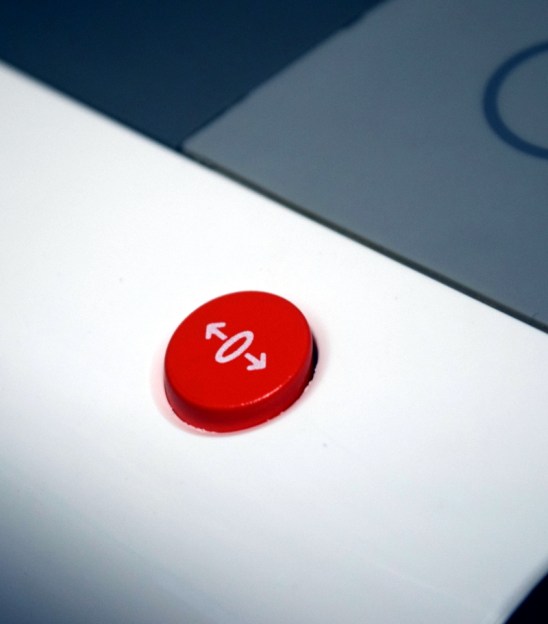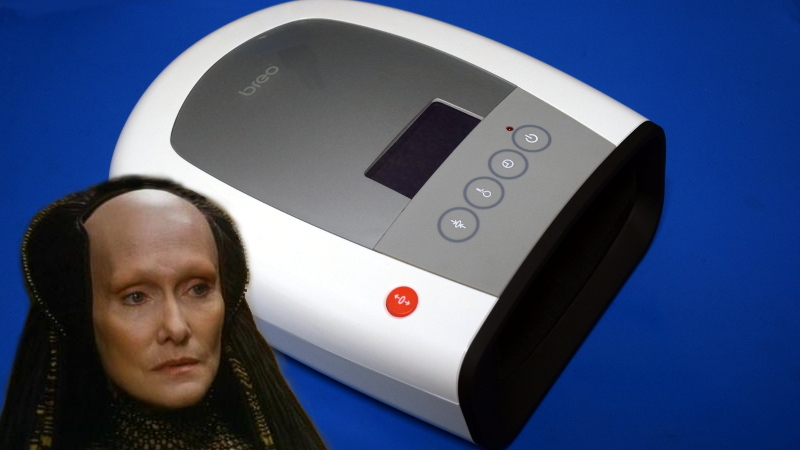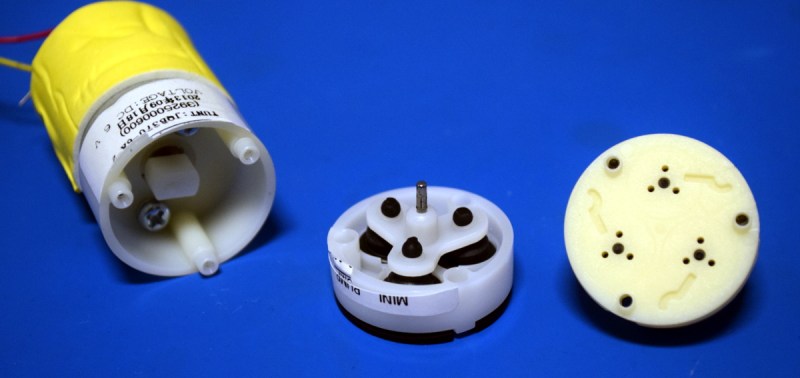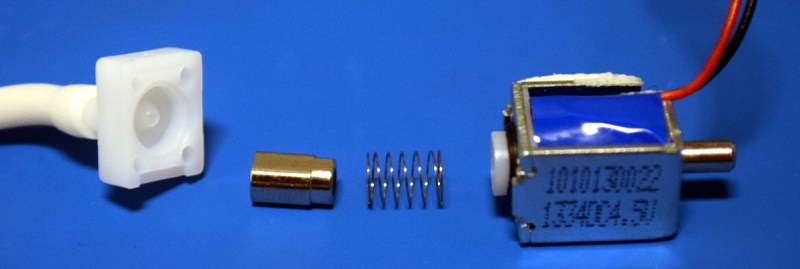I immediately felt uncomfortable when I realized this thing is called the “Breo iPalm520 Acupressure Hand Massager”. You’re supposed to stick your hand into it, and through unknown machinations it performs some kind of pressure massage complete with heating action. It’s like one of those pain boxes from Dune. It’s all the more disturbing when you realize the red button on the thing is an emergency release. That’s right, once your hand is in this contraption you can’t take it out until the thing has had its way with you or you tap out.

At least once a week I try to get to the local thrift store to look for interesting things. I’d like to be more specific than “interesting things”, but truth be told, I never really know what I’m looking for until I see it. Sure there’s the normal consumer electronics kind of stuff, but I’ve also found some very nice laboratory equipment, computer parts, software, technical books, etc. You just have to go regularly and keep an eye out for the occasional needle amongst the hay.
I want you to know, Dear Readers, that I did briefly summon the courage to put my hand into this thing and turn it on. Now I am not what one might call an overly brave man, and perhaps that might explain my personal experience. But when it started to hum and heat up, constricting around my hand to the point I couldn’t move my fingers, I screamed like a child and mashed the emergency button as if I was a pilot trying to eject from a mortally wounded aircraft. As far as Frank Herbert is concerned, I’m no human at all.
In an effort to better understand this torture device, lets open it up and see what lurks beneath that futuristic exterior.
Disassembly
David Lynch never let us look inside the box, but this is real life and I can do what I want. It’s a fair bet that, the sleeker something looks, the harder it will be to take apart without destroying it. The iPalm520 fits that description perfectly. After you locate the screws, which were naturally recessed so far into the device that I had to go dig out the long-reach drivers I never use, you still have to split the case open. The clips used to hold it together are so strong I was sure the thing would crack before I could get it apart. In fact, I did break several of the clips, despite my best efforts.
With the case opened, we can immediately see the device is pneumatic in nature. An air pump can be observed, as well as some tubing and valves. But before we get into that, let’s look at that control board on the left.
Electronics
The brains of the iPalm520 are pretty straightforward. There’s only one chip that runs the whole show, directly connected to both the LCD display and the bank of transistors that do the heavy lifting on the motor and valve outputs. The chip itself was expertly wiped of any identifying information; while I can see there used to be something written on it, even under the microscope there’s nothing I can make out.
Not much to be said about the electronics, and little that could practically be salvaged. The LCD image is very nice, but much like the main chip, there’s unfortunately no identifying marks to determine who makes it or to look up any documentation.
Pneumatic Section
This is the real heart of the device, and surely the most interesting part. We can see the air pump which provides pressure to the system, as well as two electromechanical values which are used to selectively inflate different sections of the cuff. There’s also a manual pressure relief valve, which is what gets actuated when you chicken out and press the red button on the top side of the device.
An interesting note is the electrolytic capacitor that was added hastily to the motor. We can only speculate, but it might be that this capacitor was added after it was discovered that the brushed motor was generating too much RF interference.
Pump
The air pump has a model number of JQB370, and looking it up online, this seems to be a common overseas part. Running at 6 VDC and capable of 400 mmHg (around 8 Psi), it seems this little pump is commonly used in devices such as blood pressure monitors.
The internal operation is quite fascinating. An offset coupler moves the shaft in an eccentric circle, which flexes three soft rubber bellows. In effect it’s a three cylinder piston pump, but without the complexity of physical pistons, a camshaft, etc. Perfect for lightweight mobile devices.
Valves
The two valves used in the device are especially interesting. They are essentially solenoids, with the core being used to block the flow of air through the device. The linear layout, with the air traveling through the coil section, makes for a very compact unit.
The valves strike me as exceptionally well made, and I wouldn’t be surprised if the pair of them were the most expensive element of the entire device. The numbers printed on the valve body don’t seem to correspond to anything I could find online, though a search for “mini solenoid valve” on the usual overseas websites shows very similar products.
Cuff
Finally, that brings us to the cuff itself. The outer case is exceptionally strong, no doubt to contain the pressure during operation, and according to the markings is made of ABS with 10% glass fiber reinforcement. Four air inlets correspond to four separate air bladders inside the cuff. When combined with the panels of raised rubber shapes these bladders allow the iPalm520 to selectively push different patterns against the user’s hands. While rudimentary in this particular device, pneumatic actuators such as these have applications in soft robotics.
In addition, two connectors lead down into a pocket in the cuff fabric. Here we can find the heating element and temperature sensor. This setup is actually very similar to what was used in the Christmas Laser Projector to maintain laser diode temperature.
Salvaged Parts
While the control board is something of a lost cause, the pneumatic components of this device are absolutely worth harvesting for possible future projects. The air pump and valves are ripe for reuse, and would make an excellent “starter kit” for working with air powered contraptions.
That said, given that the Breo iPalm520 retails for $130 USD, it certainly isn’t worth buying one just for the parts. In the end, this was a perfect thrift store find; it cost me something like $5, and for that price I’m quite pleased. To date my thrift store strategy has yet to fail me: if it’s got buttons and looks cool, it’s probably worth taking apart.
I love writing these teardown articles but I’m often at the mercy of what wacky equipment I happen across. If you have suggestions, or even something you’d like to send in for teardown, let us know on the tips line!


























Dude! You put your hand in that?!?! After buying it from a thrift store?
My first thought was “how much of the previous owner’s hand sweat was in there”. I came to write about that. Then… it occurred to me that hand might not be the only thing the previous owner put in there. Ewwwww!
yeah, what could someone get from using something that had been used on someones feet…?
On the basis of the replies to this story, I think the right term for the uncanniness described is “Castration anxiety”!
yes…. feet… that’s exactly what I was thinking of too….
Heh heh. Yeah, someone has had their hog in there.
If you’ve got enough “material” to fill a cuff designed for the average human hand, then you can put it wherever you want at that point.
A gnarly fungus, most likely.
Ugh, thanks to putting that image into my head. Hopefully the previous owner was as much of a coward as I am, and didn’t sweat in it too much.
https://youtu.be/4KICpbB5YQY?t=1m30s
Yes, thrift stores are an excellent source for cheap hacking projects and material. Although they have become a bit too popular here and prices have gone up considerably.
One of the Goodwills in my area has a nasty habit of pricing electronics based on how much they cost new.
Yes, I understand this keyboard cost $70 new. It’s missing the proprietary cable it needs, and is worn and dirty. It is not worth $60.
I was ecstatic when I found a pair of old 8″ 800×600 VGA screens pulled of old POS systems. $40 each. No power supply and they take a funky voltage, so they have no way of knowing if they actually work.
Ouch. I don’t think I’ve ever paid more than ~$10 for something at my local store. But if truth be told, most of the stuff they seem to have is pretty beat up, so they probably don’t think they can get away with much more than a few bucks.
They probably have no idea how much most of that stuff’s worth. You could maybe make them an offer. They might not take it but maybe after a while they’ll mark them down.
“Not much to be said about the electronics, and little that could practically be salvaged. The LCD image is very nice, but much like the main chip, there’s unfortunately no identifying marks to determine who makes it or to look up any documentation.”
A rather common practice unfortunately.
Please post a video to see this in action!
While I usually don’t do anything destructive during a teardown, this particular device got a one-way ticket. Partially because I had to cut the stitching on the cuff material to get into it, and partially because the thing creeped me out so much.
Keurig coffee-makers are an excellent source of pumps/valves/heater/plumbing parts, for all your precision-coffee-brewer (or other) applications. I’ve scavenged parts from two K60’s so far. Fun stuff!
I recall a similar project, that was actually building a Dune pain box. Apparently, If you run a bunch of metal tubes in parallel, and alternately cool and heat them mildly, the overall effect feels like burning. It’s called the “thermal grill illusion”. Can’t imagine why the Bene Gesserit went to all the trouble of inventing nerve induction.
https://hackaday.com/2015/02/21/making-the-dune-pain-box-a-reality/
I don’t know why, it somehow reminds of this nature film where a monkey grabs a treat hidden in a hole in a tree trunk. The hole is just big enough for an outstretched hand to enter it, but when the monkey grabs hold of the treat, it’s hand is trapped. The silly thing was that it never crossed its mind to release the treat to get the hand out.
You may be able to probe the pins for a serial debugging port, it might announce what chip it is.
I know a few humans that could not figure that out either, ha ha.
-Homer, are just holding onto the can?
-Your point being?
A 5 minutes DIY Gom Jabbar (shameless plug alert!)
:o)
https://hackaday.io/project/6577-dune-pain-box-a-hackers-replica
Ok non US resident here I’ve seen the term thrift store a fair bit and have developed an idea as to what it is but I’m not real sure. Is it something like a Salvo’s or St Vinnies?
It’s a store filled with random items. Think of it like a garage sale. Lots of stuff that other people do not want it have no use for anymore.
I don’t know if they are similar because I don’t know those stores.
Probably best to find a definition of thrift shop.
http://lmgtfy.com/?q=define+thrift+shop
Thanks for that. I’ve got it now, just like a salvos. :-)
On another note those small pressure pumps don’t look like much but are incredibly reliable as Tom mentioned in his article they are used in blood pressure monitors and last for years in a hospital environment.
Yes, you’ve named two that are pretty common in the States as well. The other fairly common one we have is Goodwill. Most of the ones here tend to focus on used clothing but will sell just about anything people have donated.
The difference is: Goodwill keeps the “Charity” tax immune status by hiring disabled workers.
Goodwill is a sole owner operation, and turns a tidy profit.
Salvation Army (and other faith based orgs) in contrast are actually a charity.
We have St Vincent dePaul stores here, too. Yes, that is a thrift store. Where people donate their used stuff and the store resells them. Often a portion of the profits go to some charity work of some kind.
Goodwill has shifted from being someplace that hires the handicapped to being just another business.
For instance, what we call the thrift store in my town of <10,000 people is a nonprofit store people can go into to buy stuff. The merchandise is entirely donated by the local residents and the money gathered keeps the lights on, pays the staff, and funds the food pantry for the poor. Beyond the staff, there are usually rotating teams of volunteers, usually church groups, working at both the pantry and the store. People don't just give away junk either. They bring stuff that actually has value to other people, it's just that the current owner doesn't need it anymore. Clothes, kitchenware, furniture, bicycles, tools, electronics, books, videos, jewelery, anything people would regard as valuable. Doners do get reciepts to help with their taxes too. Its a great community institution and a fantastic place to hunt for treasures while helping support the community. :-)
you win an internet for that post title.
s/values/valves/
So parts-wise it’s two blood pressure meter. :-) A BPM has only one Pump and one solenoid.
EDIT: I just saw, that this device also uses only one pump, but two valves.
> An offset coupler moves the shaft in an eccentric circle, which flexes three soft rubber bellows. In effect it’s a three cylinder piston pump, but without the complexity of physical pistons, a camshaft, etc. Perfect for lightweight mobile devices.
That’s a peristaltic pump, useful in all sorts of places. Particularly handy as the impellers never make contact with the fluid being pumped so they can be used to pump shear-sensitive fluids (blood being a common example), fluids that may have a lot of foreign matter which might otherwise get jammed into the impeller, or nasty chemicals that might interact w/ the working mechanisms of normal pumps.